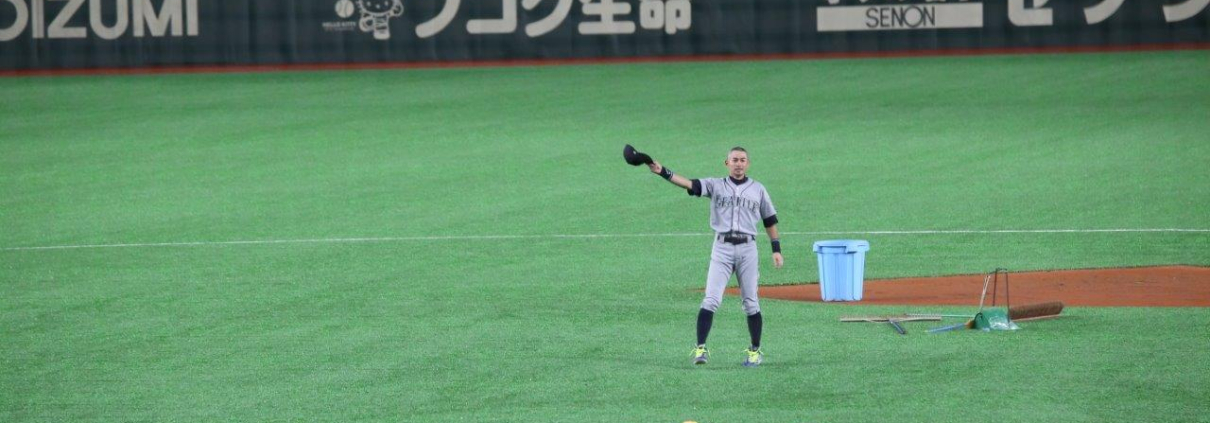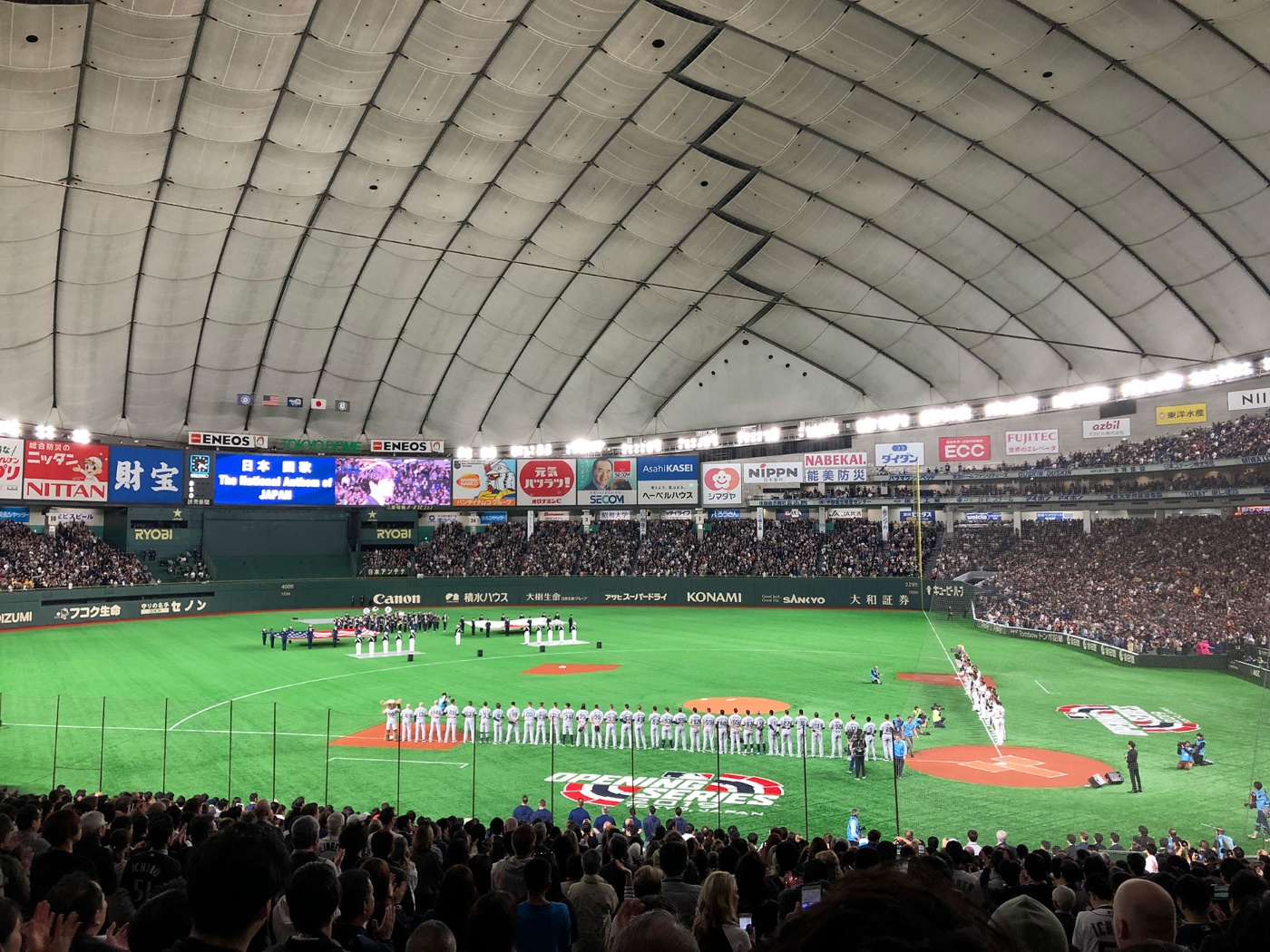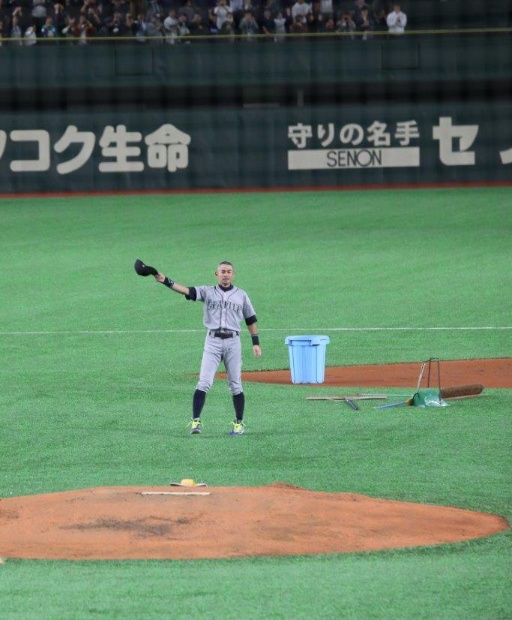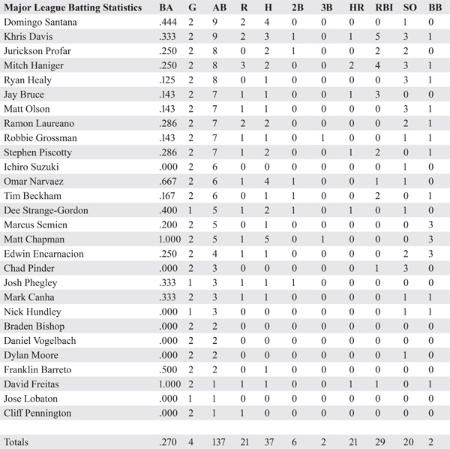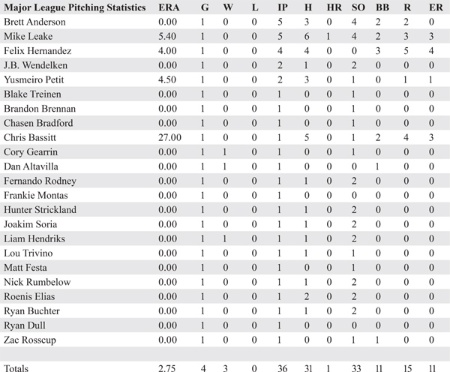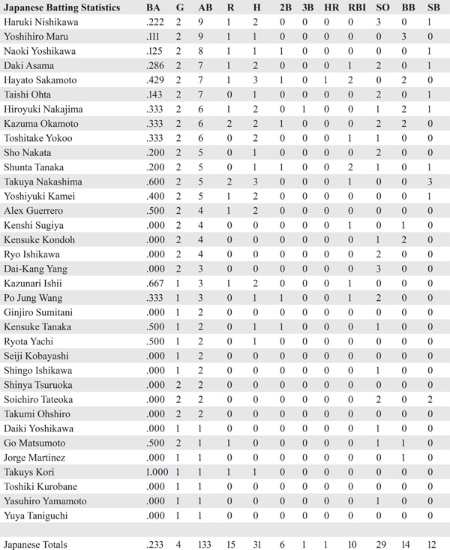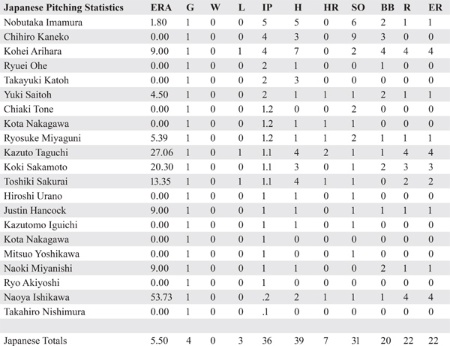2019 MLB Opening Series in Japan
This article was written by Shane Barclay
This article was published in Nichibei Yakyu: US Tours of Japan, 1960-2019
Pre-game ceremonies for the 2019 Opening Day Series (Courtesy of Shane Barclay, JapanBall.com)
The two-game 2019 “Opening Series” between the Oakland Athletics and Seattle Mariners at the Tokyo Dome served as the eighth time – the fifth in Tokyo – that Major League Baseball opened the season abroad.
To prepare for the season opener, the A’s and Mariners each played two exhibition games against Nippon Professional Baseball teams: the Mariners against the Yomiuri Giants (a subsidiary of Yomiuri, the media company that partnered with Major League Baseball to stage the series), and the A’s against the Hokkaido Nippon-Ham Fighters.
Considering that the tour’s purpose was to promote MLB’s brand in Japan, the Mariners were a natural choice to participate. The team has legions of Japanese fans due to its history of Japanese players, including Ichiro Suzuki, Mac Suzuki, Hisashi Iwakuma, Kazuhiro Sasaki, Shigetoshi Hasegawa, Kenji Johjima, and Munenori Kawasaki.
The A’s were not such an obvious selection to be showcased. Despite a surprisingly strong 2018 season, they were not a big draw. According to Jim Small, MLB’s senior vice president, international, the A’s were invited to play for various reasons:
“We generally like to take teams from the same division and always from the same spring training state. And while we have brought New York, Tampa, and Boston to Tokyo, traveling from the East Coast to Tokyo is a bit more complicated. Finally, the A’s have always embraced international play. … [T]hey love the opportunity to travel and feel that it brings their team closer together.”1
That said, this series was less about the teams and their games and more about a celebration of one man: Ichiro.
*****
Ichiro’s résumé – 17 consecutive All-Star Games and Gold Gloves, four MVPs, nine batting titles, and breaking both the major-league and NPB single-season records for base hits – makes him undoubtedly one of the best to ever play the game.
However, he had not had an excellent season since 2010. His disciplined physical preparation was legendary, but could not stave off Father Time. Ichiro embraced the role of a steady veteran, claiming in 2017 that he intended to play until he was “at least 50.”2
But after 15 games with the Mariners in 2018, the team announced a surprise transaction on May 3: Ichiro would move to a front-office role in which he would continue to train with the team but no longer occupy a spot on the roster. This announcement was interesting because it did not state that Ichiro was retiring, and just two days before, Major League Baseball had announced that the Mariners would open the 2019 season in Japan.
A few days later, Mariners general manager Jerry DiPoto declared, “There’s a strong likelihood that you will see Ichiro next year suit up, particularly in Tokyo. It’s a great opportunity for the Mariners, for Major League Baseball, and for [NPB].”3
Throughout the rest of the 2018 season, Ichiro maintained his meticulous physical regimen, staying in game shape. He would suit up come March 2019, but would the tour serve as his retirement ceremony?
When the new year began, the people of Japan already knew that 2019 would be a year of significant transition. In an unprecedented move, Japan’s 85-year-old Emperor Akihito decided to abdicate the throne because of declining health.4 Come April 30, 2019, a new era would formally begin.
The imperial leader of Japan would step down soon; would he be joined in retirement by a baseball prince?
*****
The Oakland A’s reported to spring training in 2019 with high expectations. After three rebuilding seasons, the 2018 A’s finished second in a strong AL West and earned a spot in the postseason. The club’s executive vice president of baseball operations, Billy Beane, had worked his magic again, putting together a talented, low-payroll team that played loose and with a chip on its shoulder. The players seemed determined to prove that 2018 was no fluke.
The 2019 Seattle Mariners were trending in the opposite direction. After leading the team through three straight disappointing seasons, DiPoto traded star second baseman Robinson Canó and young closer Edwin Díaz to the New York Mets, and let veteran slugger and team leader Nelson Cruz depart in free agency. DiPoto made it clear that developing young talent would be the team’s focus in 2019.
The teams arrived in Tokyo on March 15 with hordes of media and fans waiting for them at the airport, treating even the relatively unknown players like rock stars.5 All of the attention and adoration amused players from both teams.
During initial media sessions, Ichiro emphasized savoring the moment. He said, “This is a great gift for me. I will treasure every moment here on the field. One week after this event, I will be reflecting back on these days, so I will make sure I remember every moment here in Japan.”6 This was a break from the norm for Ichiro, who throughout his career employed a legendary single-mindedness on being the best ballplayer possible.7
After workouts at the Tokyo Dome on the 16th, the major league teams got their first taste of Japanese baseball on Sunday, March 17.
A standing-room-only crowd of 46,315 packed the Tokyo Dome for the day’s first game, between the Mariners and Yomiuri Giants. The Giants are Japan’s most popular team, but the Japanese fans who showed up made it clear with their cheers and apparel that they were there for Ichiro. Every move he made before the game was met with an audible buzz in the domed ballpark.
Ichiro Suzuki takes a curtain call after his final major league game, March 21, 2019 (Courtesy of Shane Barclay, JapanBall.com)
The Mariners showed no jet-lag in the top of the first inning, plating a run on a sacrifice fly by Jay Bruce. Three Mariners reached base, meaning that the fans would already get to see Ichiro, who was slotted ninth in the batting order, bat in the second inning.
Ichiro showed a selective eye in his first at-bat. He took a strike, three consecutive balls, and another strike. With each pitch, the anticipation of the fans grew. It seemed that few of them were not capturing each pitch on their cell phone, and all of them held their breath. Ichiro finally swung on the full-count offering and lofted an innocent fly ball into the glove of Giants center fielder Yoshihiro Maru.
Nobutaka Imamura settled down after that rocky first inning, leaving with a 3-1 lead after the fifth inning.
The Giants built their lead by standing on the lean but broad shoulders of their franchise-cornerstone shortstop, Hayato Sakamoto. Sakomoto, just 30 years old, already had 10 All-Star selections and showed in this game that he could compete on any stage. He knocked in a run with a single off Mariners starter Mike Leake in the third, and then in the fifth launched Leake’s 0-and-2 curveball into the left-field stands. He also had an RBI single in the ninth, finishing the game with three run-scoring hits.
The Giants brought in Kazuto Taguchi to protect the lead. He pitched a scoreless sixth, which included inducing a soft groundout by Ichiro to end the inning (and the night for Ichiro, who was replaced in right field to start the seventh). The Mariners’ bats then came to life, as both Mitch Haniger and Jay Bruce hit home runs in the seventh and Dee Strange-Gordon in the eighth. Reliever Roenis Elías sealed the 6-4 victory for Seattle.
Without the allure of Ichiro, attendance for the second game of Sunday’s doubleheader was 26,198. Those who came were treated to a ceremonial first pitch by Masanori Murakami, who in 1964 became the first Japanese player in the US major leagues when he debuted for the San Francisco Giants. The 74-year-old Murakami showed that he still had some strength in that left arm; he wound up and threw a high pitch to A’s third-base coach and fellow former San Francisco Giant Matt Williams.
The MLB visitors again didn’t miss a beat: The A’s loaded the bases in the first inning with a triple by leadoff hitter Robbie Grossman and two walks. However, starting pitcher Kohei Arihara kept the damage to a minimum, allowing just one run on an RBI groundout by Khris Davis.
The next time around, the heart of the A’s order broke through with consecutive hits from their second batter, Matt Chapman, through their sixth hitter, Jurickson Profar. They plated three runs in the third and another in the ninth. The five runs were plenty for a barrage of eight A’s pitchers who limited the Fighters to one run and secured a 5-1 victory.
Despite a smaller crowd, the fans were lively. “It’s a carnival atmosphere,” A’s manager Bob Melvin said. “There’s a lot going on that’s different from the States. It’s one of the things our guys were looking forward to and it lived up to the billing.” Liam Hendricks, who pitched the first inning, added, “I loved it out there. The constant cheering and constant sound was really cool. There’s no lull moments. It’s go, go, go all the time.”8
Well, not all the time. An interesting dynamic at these MLB/NPB matchups was the disparity in crowd noise between the top and bottom half of each inning. Japanese baseball fans are famously boisterous, but the majority of their noise is in the form of well-practiced songs – complete with accompanying percussion and horns – that are prepared for each batter in the lineup. In a typical NPB game, the fans of the team on offense sing and drum each player’s song for the duration of his at-bat. Once the half-inning is over, the other team’s fans take over. Therefore, in these exhibition games the Japanese fans diligently cheered for their players when the NPB team was batting, but when the major league team was batting, the ballpark fell eerily silent.
The MLB/NPB matchups would be the same the following day, Monday, March 18, but the time slots were reversed to showcase the more popular Giants and Ichiro in the weeknight prime-time slot. That meant that the A’s and Fighters had a quick turnaround from the night before, playing at noon in front of 13,588 fans.
The hitters from both teams, who combined for 19 hits the night before, continued to show proficiency at the plate, with nine hits per team, but the Fighters’ offense was more opportune. They took advantage of three Oakland errors to score three unearned runs, and almost everyone got involved: seven Fighters batters recorded at least one base hit, and six of them scored one run each.
Leading 6-3 with two on and two out in the top of the ninth, the Fighters were primed to split the two-game series. But then Davis lifted a first-pitch hanging curveball from closer Naoya Ishikawa into the left-field stands. The game ended in a 6-6 tie as the teams had agreed not to play extra innings in the exhibition games.
The final exhibition presented an opportunity for Japanese fans to see another major league star whose career was coming to a close. Starting for the Mariners was their former ace, Felix Hernandez. “King Felix” was a six-time All-Star and winner of the 2010 AL Cy Young Award but now, as he approached 33 years old, the Venezuelan’s electric right arm had dimmed. The Giants touched him up for five runs on four hits and three walks. Most telling was that the pitcher who earlier in his career struck out over 200 hitters for six consecutive seasons recorded zero strikeouts. Hernandez left the game after the fourth, trailing 5-3.
The Giants’ lead did not hold, though, as Haniger smashed a fastball from Toshiki Sakurai over the left-field bleachers and into a faraway banner, tying the game in the seventh.
Mariners catcher David Freitas continued the power surge in the ninth, celebrating his 30th birthday in style. He lifted a knee-high fastball down the left-field line and into the second row of the bleachers for a go-ahead solo homer off Kota Nakagawa. After Mariners reliever Chasen Bradford finished off the Giants in order in the bottom half of the inning, the birthday boy Freitas was named “hero of the game,” a Japanese postgame tradition.9
Ichiro again did not show much with the bat, finishing 0-for-3. He did, however, wow the crowd in the third inning with a strong throw from deep right field to third base that kept the Giants runner from advancing. The throw lacked the zip that Ichiro’s powerful arm deployed in his prime but was still a thing of beauty. It reached third baseman Ryon Healy on the fly, directly to his chest. Exhibiting a mix of surprise and amusement, Healy smirked upon receiving the throw.10
*****
With the exhibition games completed, a day off and the two games that counted remained. That did not mean that the journey turned into strictly a business trip. Although players from both teams made it clear that they would take the two regular-season games seriously, their coaches encouraged them to take full advantage of the opportunity to experience a new country.11
Mariners manager Scott Servais was spotted walking the perimeter of the Imperial Palace, and A’s shortstop Marcus Semien wandered through the glistening district of Shibuya.12 Japanese cuisine seemed to be a common thread in what the Americans were excited to experience.
No traveler, however, was more gastronomically enthused than Oakland outfielder Mark Canha. Canha’s adventurous palate was influenced as a child by his food-loving father, who liked to recreate foreign dishes that he tried on global business trips.13 Canha and his wife, Marci, made the best of the opportunity, dining at street-food stalls that served traditional pastries, high-end restaurants where they ate dishes like a “quail egg yolk and caviar atop fresh tuna,” and everywhere in between.14
*****
March 20, 2019, was the Spring Equinox. What better way to celebrate the arrival of spring than with Opening Day? At the Tokyo Dome, the center of the baseball world during these two games, the excitement was palpable. The crowded outside plaza was full of festivities, and thousands of ticket-holders waited in line for the ballpark’s revolving doors to open.
The attendance was 45,787, and hardly a single fan arrived after first pitch. The dome’s interior was ornamented with traditional red, white, and blue bunting, but the most prominent colors were the Mariners’ navy blue, Northwest green, and silver because Mariners fans from both sides of the Pacific turned out in droves.
At 6:36 P.M. JST (2:36 A.M. in Oakland and Seattle), the 2019 season was underway with a first-pitch fastball from A’s pitcher Mike Fiers that leadoff hitter Strange-Gordon lined sharply into the glove of right fielder Stephen Piscotty.
The hard-hit ball was a harbinger of things to come. Piscotty put Oakland on the board with a solo home run in the bottom of the first off Marco Gonzalez, and the A’s tacked on another run in the second. They made it three innings in a row with a run when Davis hit a two-run homer in the third, but not before Domingo Santana recorded the game’s biggest hit in the top half.
With one run already in and the bases loaded, the Dominican slugger lined an outside fastball from Fiers deep to the opposite field, landing just over the fence in the right-field corner for a grand slam. Fiers’ first Opening Day start was done after three innings.
Seattle’s Tim Beckham delivered another big blow, a fifth-inning two-run homer that made it 9-4. Oakland’s Chapman made things interesting with a three-run blast in the seventh, but closer Hunter Strickland recorded the save with a one-two-three ninth, and the Mariners prevailed, 9-7.
Ichiro had another quiet day at the plate. Batting from the ninth slot, he popped out to second in the third inning and walked in the fourth. After the side was retired, Ichiro jogged out to his position in right field and was promptly called back into the dugout by Servais, which allowed the adoring crowd to give him a rousing ovation.
Batting Ichiro last and removing him after two at-bats proved that the Mariners clearly did not feel he would be a significant contributor. It was a delicate balance for Servais, who after the game said, “We certainly want to give him an opportunity to go out and play, but we also want to get some other guys in the game. I understand everybody wants to see him go all nine innings. We’re trying to do the best thing for the team and Ichiro understands.”15
The second game, on Thursday, March 21, was one that nobody in attendance would soon forget: It was time to say goodbye to the national hero. Ichiro had not officially announced his retirement yet, but the writing was on the wall: The Mariners’ minimal use of him indicated that he would not remain with the team when it pared its roster from 28 players to 25 upon returning to the United States. The announced crowd of 46,451 arrived early and savored every chance they had to catch a final glimpse of Ichiro.
Taking the hill for Seattle was Yusei Kikuchi, the team’s most recent Japanese import. The 27-year-old lefty pitched nine seasons for the Saitama Seibu Lions before they posted him to MLB teams. DiPoto felt that his stuff would play against major-league hitters and signed him to a four-year contract in January. After a month of spring training in Arizona, Kikuchi was back home, but now with the MLB logo on the back of his cap.
Kikuchi made quick work of the A’s in the first, retiring them in order and recording his first strikeout. With his pitch count at 91 in the fifth inning, Servais removed Kikuchi from the game. The proud crowd gave Kikuchi a warm applause as he returned to the dugout. In his first major league start, Kikuchi allowed one earned run and one walk with three strikeouts in 4⅔ innings.
Ichiro got his first at-bat in the second. Tens of thousands of fans simultaneously opened their cell phones’ camera applications as he strode to the plate. He worked a hitter’s count and offered at Marco Estrada’s 2-and-1 pitch, but this at-bat would not produce an iconic moment: He popped out into foul territory.
Ichiro’s next at-bat came in the fourth inning. By now word had spread around the ballpark that Kyodo News reported that Ichiro would announce his retirement after the game.16 “Just one more hit, please!” seemed to be the thought on everyone’s mind. However, Estrada again retired Ichiro, inducing a fielder’s-choice groundout. The fans were relieved that Ichiro remained in the game for the bottom half, indicating that he would get at least one more opportunity to leave on a high note.
When Ichiro stepped to the plate in the top of the seventh, it was possibly his final at-bat. The tone of the fans’ cries was a mix of appreciation and desperation as they pleaded for him to get a hit. He worked the count to 2-and-2 against Joakim Soria. Soria’s fifth offering caught Ichiro off-guard – the changeup sank into catcher Josh Phegley’s glove, and the umpire signaled strike three. The crowd sighed a quick groan but then burst into applause for Ichiro. He cast his eyes down to the deep-green field turf as he walked back to the dugout, his blank expression revealing a hint of sadness.
Even the Oakland fans were desperately hoping that enough Mariners batters would reach base for Ichiro to have one more shot. Fortunately, three more batters reached base. Servais agreed with the 46,000-plus who envisioned a better ending for Ichiro; he did not call Ichiro back into the dugout for a hero’s exit after he trotted out to right field in the bottom half.
His final chance came in the top of the eighth, against A’s reliever Lou Trivino. Ichiro did precisely what he had done in nearly 15,000 previous professional plate appearances: took a looping practice swing outside the batter’s box, stepped toward the plate, dropped into a low crouch to stretch his legs, entered the box, smoothed out the dirt with his left foot, and struck that iconic pose – right hand extended toward center field, bat pointed toward the sky, left hand angled toward his right shoulder, and both eyes square to the pitcher. Trivino came set, and Ichiro hiked his right sleeve up with his left hand and circled his black Mizuno bat down and back into a gentle, two-handed grip. With both knees slightly bent and pointing inward, he awaited the pitch.
Ichiro’s last professional at-bat was an appropriate encapsulation of the previous couple of years: he held on, but ultimately could not produce. He fouled off two tough 1-and-2 pitches, refusing to go down easily.
Trivino’s sixth offering was hittable – a sinking, thigh-high fastball on the outer half. A younger Ichiro probably would have deposited the pitch into the outfield for a base hit, but 45-year-old Ichiro pounded it into the ground toward the left of second base.
Shortstop Semien charged and fielded the ball just in front of the baseline. He double-pumped before throwing – a hesitation that many were hoping would allow Ichiro to beat the throw to first. Ten years ago, Ichiro would have been well past the bag when the ball arrived, but here, in Tokyo in 2019, he was out by a half-step.
It would have felt perfect for Ichiro to end his career on an infield single, legging out a hit as he had for two decades. But the game had made clear to Ichiro what it emphatically taught countless ballplayers before: Baseball may be timeless, but every player’s time runs out.
Ichiro took his position in right field to start the bottom of the eighth. After a few moments, Servais emerged from the dugout and motioned for the fielders to come back. Ichiro pointed toward Servais in acknowledgment, turned toward the fans behind him, and raised both arms toward them. They roared in response. After a few more waves, he jogged toward the dugout.
When he reached the infield, Ichiro appeared to remember his intention from earlier in the week – to “treasure every moment here on the field.” He slowed to a walk, continuing to gesture toward the crowd in gratitude. His teammates awaited by the dugout. Ichiro hugged everyone, and then took a curtain call.
Tears were on the faces of Strange-Gordon, his good friend and teammate, and Kikuchi, who must have been overwhelmed by the emotion of making his US debut and seeing one of his childhood heroes retire in the same game. Ichiro descended back into the dugout, where he was bear-hugged by Mariners icon Ken Griffey Jr. (who participated in the first-pitch ceremony), one of few who knew how it felt to go from being one of the best in the world to not good enough. Ichiro grabbed his bat, helmet, and glove and descended into the clubhouse.
There was still baseball to be played, but with the emotion drained from the building, both teams’ bats fell silent. The 4-4 game extended into extra innings.
In the 12th, A’s pitcher Fernando Rodney relieved Ryan Buchter and walked Edwin Encarnación to load the bases. He then induced a groundball to shortstop that appeared destined to be an inning-ending double play, but a sloppy turn by the Oakland middle infielders allowed Santana to reach safely. The Mariners led 5-4.
Hunter Strickland entered the game for the Mariners and again retired the side in order to notch his second save in as many days.
*****
The game lasted more than four hours, but the fans wanted one more chance to say goodbye. They chanted “I-CHI-RO!” and clapped their hands, demanding an encore. Stadium employees eventually turned off the main lights, but the crowd would not dissipate.
After more than 30 minutes, their hero emerged. The crowd erupted, and Ichiro repeatedly gestured in appreciation. He made his way around the field, flanked by dozens of photographers who captured every wave and nod. He completed a full lap, hands waving and face full of gratitude.
Finally, he escaped the throng of photographers and trotted out toward second base. He stood in the middle of the field, all by himself, soaking it in and applauding the crowd. The ballplayer appeared to be as grateful for the fans as they were for him. He spun 360 degrees, tipping his cap to all corners of the ballpark.
This was the closure that all parties needed. Ichiro walked in reverse toward the dugout, hands raised, and then skipped in a sideways motion off the field with a lightness that he hadn’t shown all week.
SHANE BARCLAY is the owner of JapanBall, which disseminates information about Japanese baseball and offers guided baseball tours around the globe. He spent eight years working in International Baseball Operations at the MLB’s Commissioner’s Office in the Dominican Republic and New York.
Notes
1 Jim Small, email interview, December 6, 2021.
2 “Ichiro Suzuki Wants to Return to Marlins, Play Until ‘At Least 50,’” ESPN.com, September 30, 2017. https://www.espn.com/mlb/story/_/id/20868828/ichiro-suzuki-wants-return-miami-marlins-play-least-50.
3 “Baseball: Ichiro Suzuki Likely to Play in Tokyo in 2019: Mariners GM,” Kyodo News, May 8, 2018. https://english.kyodonews.net/news/2018/05/233ccda7e5b5-baseball-strong-likelihood-ichiro-will-play-in-tokyo-in-2019-mariners-gm.html.
4 Linda Sieg and Kaori Kaneko (Reuter’s), “Japan’s Emperor Akihito to Abdicate on April 30, 2019,” November 30, 2017. https://www.reuters.com/article/us-japan-emperor/japans-emperor-akihito-to-abdicate-on-april-30-2019-idUSKBN1DV3AS.
5 Martin Gallegos, “Japan Journal: Avoiding Jet Lag on the Trip to Tokyo for A’s Baseball,” San Jose Mercury News, March 16, 2019. https://www.mercurynews.com/2019/03/16/japan-journal-avoiding-jet-lag-on-the-trip-to-tokyo-for-as-baseball/.
6 Stephen Wade (Associated Press), “Ichiro in Japan: Still Enjoying the Big Leagues While He Can,” Seattle Times, March 16, 2019. https://www.seattletimes.com/sports/ichiro-in-japan-still-enjoying-the-big-leagues-while-he-can/.
7 Wright Thompson, “When Winter Never Ends,” ESPN.com, March 7, 2018. http://www.espn.com/espn/feature/story/_/id/22624561/ichiro-suzuki-return-seattle-mariners-resolve-internal-battle.
8 Martin Gallegos, “A’s Exhibition Win Livened Up by Unique Tokyo Dome Atmosphere,” San Jose Mercury News, March 17, 2019. https://www.mercurynews.com/2019/03/17/oakland-athletics-tokyo-series-mlb-ichiro-japan/.
9 Shannon Drayer, “Ichiro, Haniger, Freitas Provide Highlights as Mariners Win Final Exhibition over Yomiuri Giants,” mynorthwest.com, March 18, 2019. https://sports.mynorthwest.com/617011/drayer-mariners-win-final-exhibition-yomuiri-giants/.
10 Eric Chesterton, “Ichiro Showed That He Still Has a Cannon with a No-Hop Throw to Third,” Cut4 by MLB.com, March 18, 2019. https://www.mlb.com/cut4/ichiro-throw-in-japan.
11 Daniel Brown, “A’s, Ichiro (and Pigeons) on the Menu as Major League Baseball Opens in Tokyo,” The Athletic, March 17, 2019. https://theathletic.com/872727/2019/03/17/as-ichiro-and-pigeons-on-the-menu-as-major-league-baseball-opens-in-tokyo/.
12 Susan Slusser, “A’s Great Rickey Henderson Attracts Fans in Japan, Too,” San Francisco Chronicle, March 17, 2019. https://www.sfchronicle.com/athletics/article/A-s-great-Rickey-Henderson-attracts-fans-in-13694923.php.
13 Daniel Brown, “Mark Canha, the A’s Biggest Foodie, Takes on Japan: ‘It Was a Meal That I’ll Never Forget,’” The Athletic, March 20, 2019. https://theathletic.com/878775/2019/03/20/mark-canha-the-as-biggest-foodie-takes-on-japan-it-was-a-meal-that-ill-never-forget/.
14 Mark Canha (@bigleaguefoodie), “One of the More Beautiful Dishes We’ve Eaten This Trip at Shirosaka!,” Instagram, March 19, 2019. https://www.instagram.com/p/BvNefLTAoZf/.
15 Associated Press, “Ichiro Cheered at Tokyo Dome, Mariners Top A’s 9-7 in Opener,” ESPN.com, March 20, 2019. https://www.espn.com/mlb/recap/_/gameId/401077162.
16 Jim Allen, “Baseball: Ichiro Announces Retirement, Sent Off with Ovation,” Kyodo News, March 22, 2019. https://english.kyodonews.net/news/2019/03/04dcfafa0ae3-urgent-baseball-ichiro-to-announce-his-retirement-source.html.
17 These tables include all participants in the series. https://www.mlb.com/scores/2019-03-17/.


